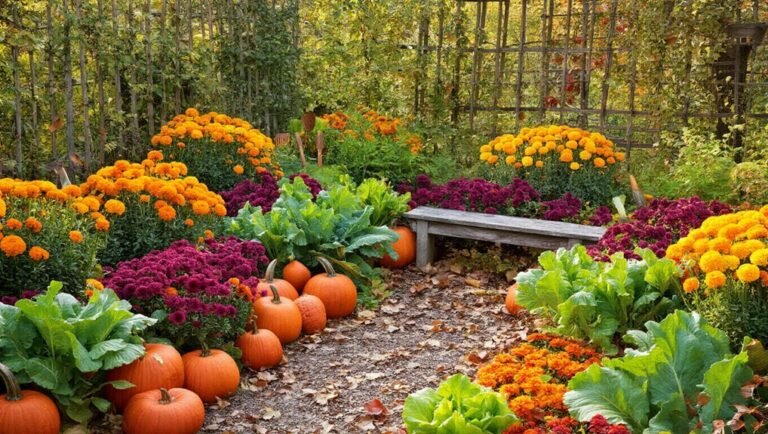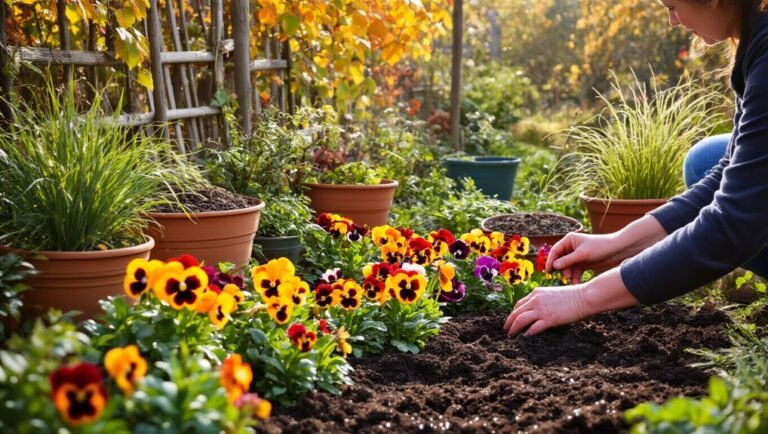To create a flourishing flower garden, start by choosing the right location with plenty of sunlight and well-drained soil. Select a mix of flower varieties that bloom at different times throughout the seasons. Plan your layout to maximize visibility and access, and prepare your soil by enriching it with organic matter. Water efficiently and keep an eye out for pests. With thoughtful care, your garden will thrive, and there’s more to discover for optimal blooms.
Key Takeaways
- Choose a sunny location with well-drained soil and easy access for maintenance to ensure healthy blooms.
- Select a mix of vibrant flowers suited for your climate, incorporating early, mid, and late bloomers for continuous color.
- Regularly inspect your garden for pests and introduce natural predators like ladybugs to maintain a balanced ecosystem.
- Amend soil with compost each season to promote nutrient-rich conditions for optimal flower growth.
- Use efficient watering techniques, such as drip irrigation, and check soil moisture to keep flowers hydrated without overwatering.
Choose the Right Location for Your Garden
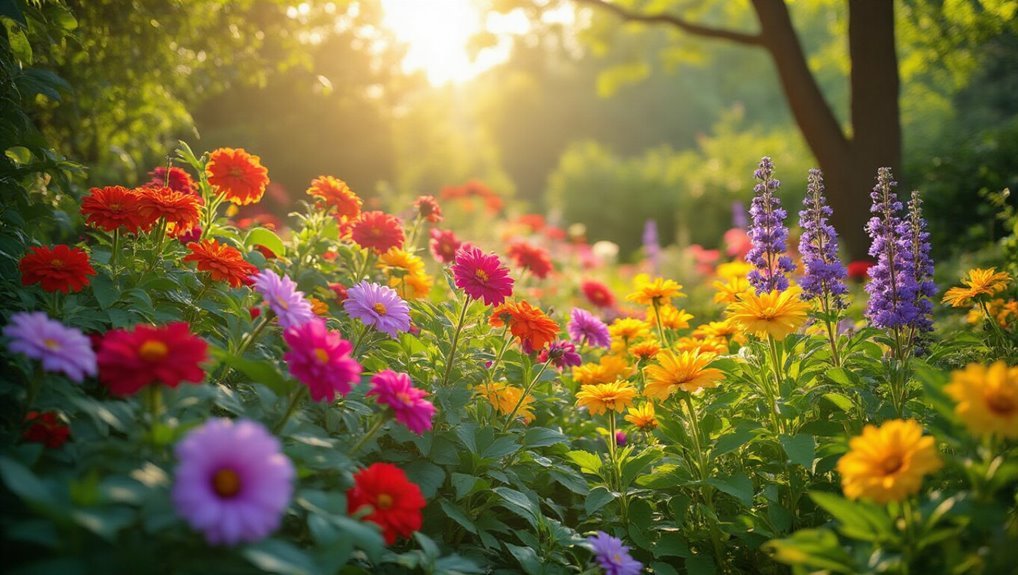
When you’re planning your flower garden, choosing the right location is crucial for success.
Start by assessing sunlight; most flowers need at least six hours of direct sunlight daily. Avoid shady spots where growth can be stunted.
Next, consider drainage; well-drained soil prevents waterlogging and root rot, so look for elevated areas or amend your soil if necessary. For efficient watering systems, having the appropriate garden hose connectors and adapters ensures compatibility between your hose and various watering tools.
Proximity to a water source is also important, as it makes watering easier.
Observe wind patterns, too; protecting delicate blooms from strong winds can enhance their health and longevity.
Lastly, think about accessibility for maintenance; a well-placed garden allows you to tend to your flowers without hassle.
For even easier watering and tidier outdoor spaces, consider the benefits of Garden Hose Reels to keep your hoses organized and within reach.
Select the Best Flower Varieties
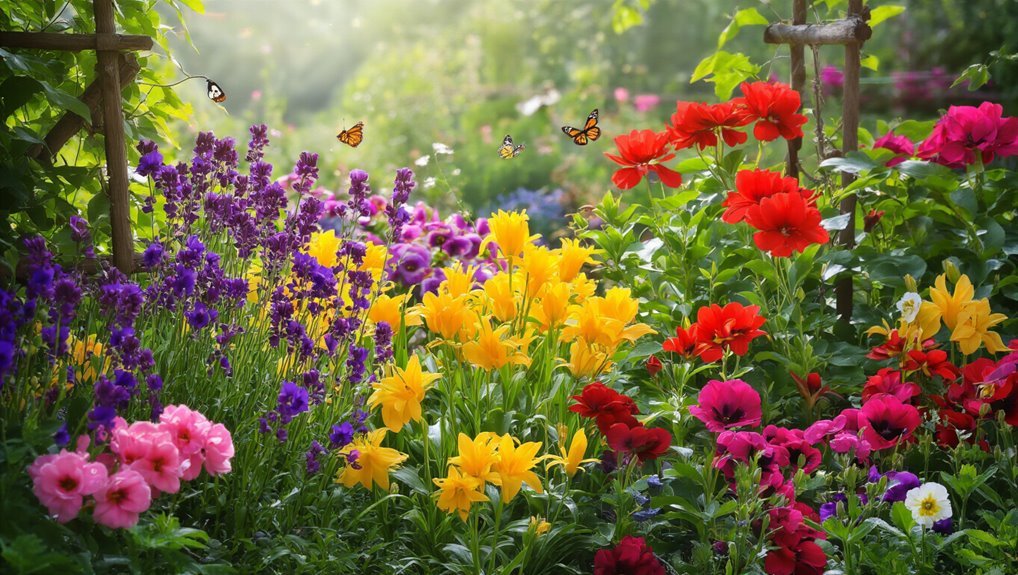
Selecting the best flower varieties for your garden can make all the difference in creating a stunning display. Start by considering your climate and soil type, as some flowers thrive better in certain conditions. For even healthier blooms, ensure you use quality garden soil to provide essential nutrients and support robust root growth. For sunny spots, opt for vibrant options like sunflowers or marigolds. If you have shaded areas, go for impatiens or ferns.
Think about the blooming season too; choose a mix of early, mid, and late bloomers to ensure continuous color throughout the year. Don’t forget to consider the height and spread of each plant to create visual interest.
Lastly, include native species, as they’ll attract local pollinators and require less maintenance.
For a unique and flavorful addition to your garden, consider planting Edible Flower Seeds, which not only add beauty but can also be used in your kitchen for culinary creations.
With the right selections, you’ll enjoy a flourishing garden that captivates all who see it.
Plan Your Garden Layout
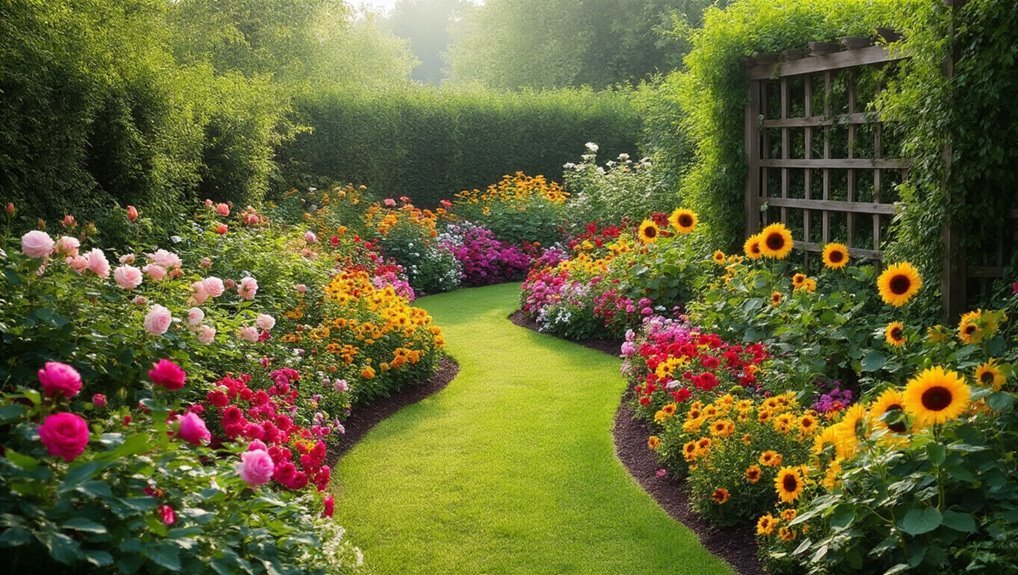
A well-planned garden layout can transform your outdoor space into a stunning landscape. Start by sketching your garden on paper, considering the sun and shade patterns throughout the day. Group taller plants at the back and shorter ones in front for visibility. For even better results, try incorporating raised garden beds to improve soil quality and drainage in your garden.
Here’s a simple layout to inspire you:
| Plant Type | Color |
|---|---|
| Sunflowers | Yellow |
| Lavender | Purple |
| Marigolds | Orange |
| Petunias | Pink |
Incorporating Self-Watering Planters can make garden maintenance effortless and ensure your plants receive consistent moisture. Incorporate pathways for easy access and create focal points with unique plants or garden ornaments. Remember, a thoughtful arrangement not only enhances aesthetics but also promotes healthy growth. Happy gardening!
Prepare the Soil Properly
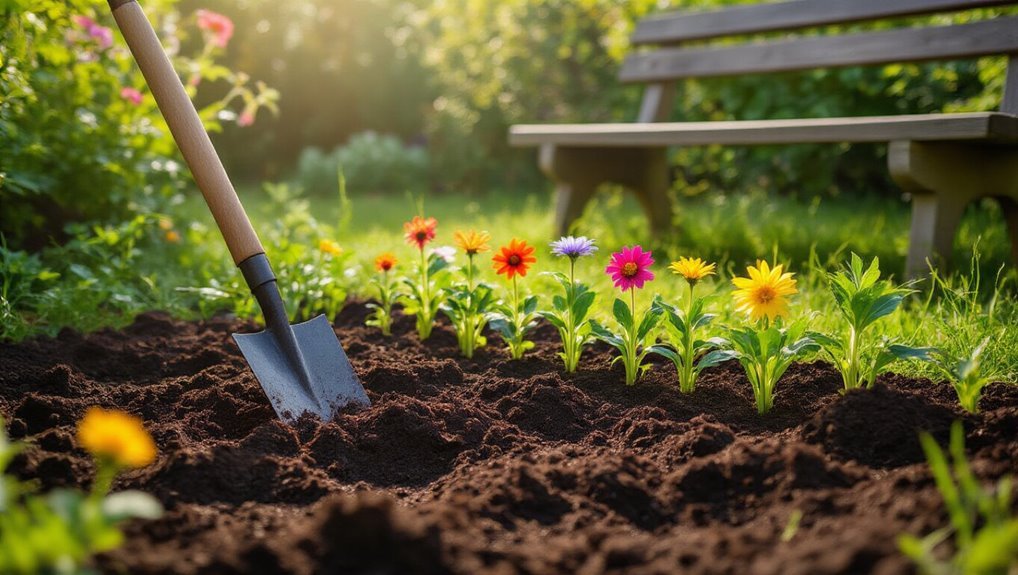
Preparing the soil properly is crucial for the success of your flower garden, as it lays the foundation for healthy plant growth.
Start by testing your soil’s pH and nutrient levels; this helps you understand what amendments are needed. Next, remove any weeds, rocks, or debris to create a clean workspace. For gardeners interested in sustainability, incorporating compost bins into your routine provides a steady supply of rich organic matter to further enhance your soil.
Loosen the soil with a garden fork or tiller to improve aeration and drainage. Incorporate organic matter, like compost or well-rotted manure, to enrich the soil and enhance its structure.
Aim for a balanced mix of sand, silt, and clay to support your flowers. Finally, level the soil to ensure even planting and prevent water pooling.
To further support your garden, consider using mulch to help retain soil moisture, suppress weeds, and regulate soil temperature. With well-prepared soil, your flowers will thrive beautifully!
Watering Techniques for Healthy Blooms
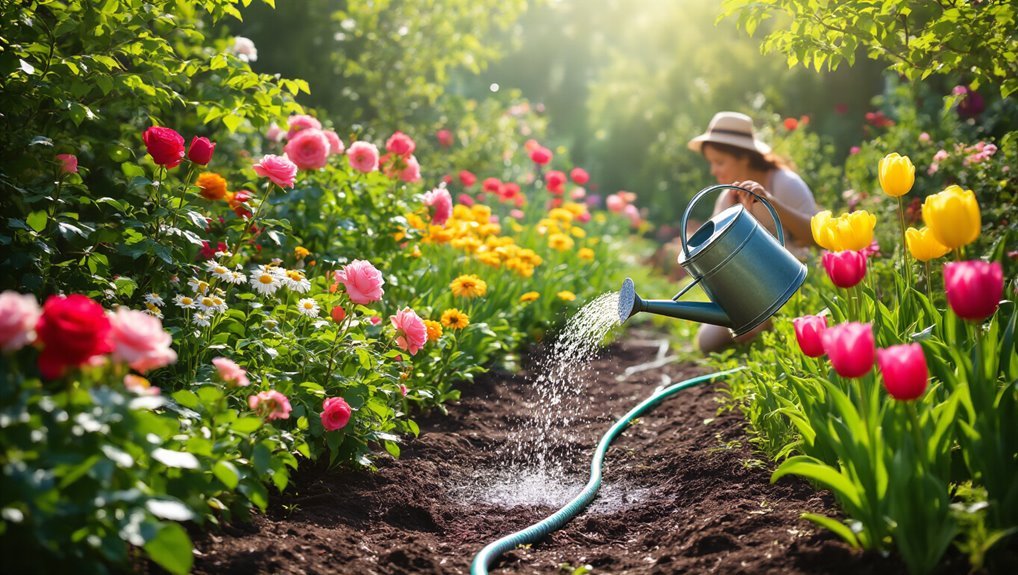
Effective watering techniques are essential for promoting healthy blooms in your flower garden.
First, water early in the morning or late in the afternoon to minimize evaporation. Aim to provide about one inch of water per week, either through rainfall or irrigation. For added convenience and consistent watering, consider using a garden sprinkler timer to automate your irrigation schedule.
When you water, do it deeply but infrequently, encouraging roots to grow deeper into the soil. Use a soaker hose or drip irrigation for efficient watering, as this minimizes water waste and keeps foliage dry, reducing disease risk.
A great way to maximize your garden’s potential is by installing drip irrigation systems, which deliver water directly to plant roots and conserve resources.
Always check soil moisture before watering; if the top inch feels dry, it’s time to hydrate.
Lastly, consider your flowers’ specific needs, as some varieties may require more or less water to thrive.
Happy gardening!
Fertilizing Your Flowers for Optimal Growth
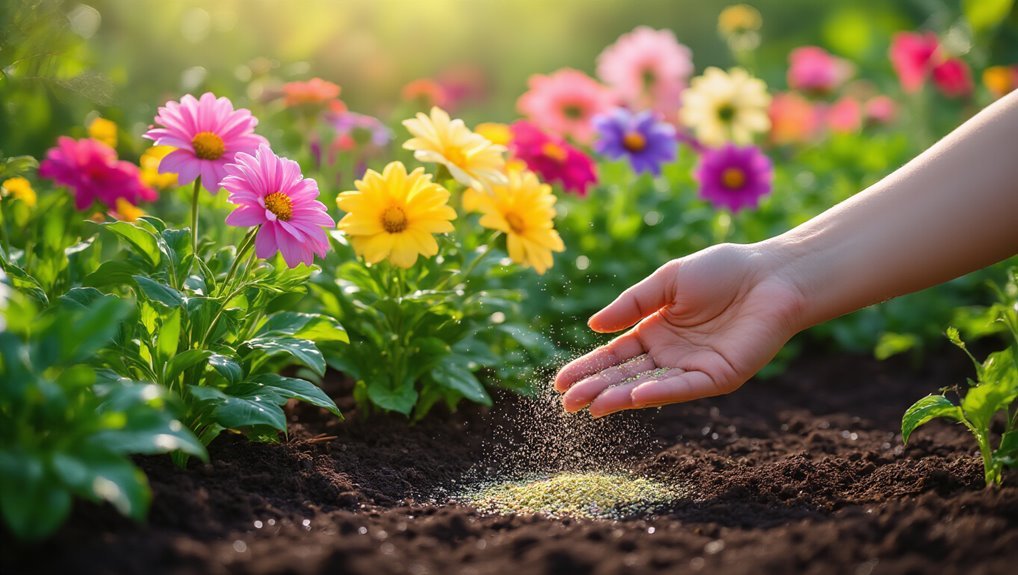
Watering your flowers properly lays the groundwork for their growth, but fertilizing them is just as important for achieving vibrant blooms.
To ensure your flowers thrive, follow these essential fertilizing tips:
- Choose the Right Fertilizer: Opt for a balanced, slow-release fertilizer that suits your flower type.
- Timing Matters: Fertilize in early spring when plants start to grow, and again during mid-summer for a boost.
- Follow Instructions: Always adhere to the recommended dosage on the fertilizer package to avoid over-fertilization.
- Water After Application: After fertilizing, give your flowers a good drink to help the nutrients penetrate the soil.
If you want to explore more options, plant food products are widely available and can help meet your garden’s nutritional needs.
For an easy and effective option, consider using plant fertilizer tablets to provide a steady supply of nutrients to your garden.
Pest and Disease Management Strategies
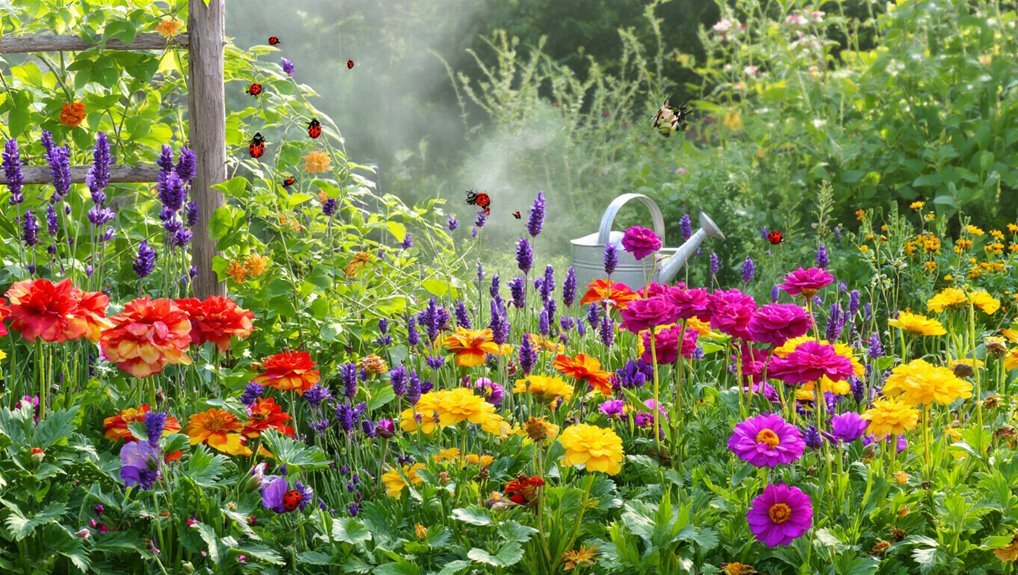
While flowers can bring beauty to your garden, they’re often susceptible to pests and diseases that can undermine your hard work. To keep your blooms healthy, implement these strategies:
| Strategy | Description | Frequency |
|---|---|---|
| Regular Inspection | Check plants for signs of pests | Weekly |
| Natural Predators | Introduce ladybugs or lacewings | As needed |
| Organic Sprays | Use neem oil or insecticidal soap | Bi-weekly |
| Crop Rotation | Change plant locations annually | Annually |
| Healthy Soil | Amend soil with compost | Every season |
Utilizing organic pest control solutions can further safeguard your flower garden without harming beneficial insects or the environment. Many gardeners also achieve success by selecting effective solutions for pest control products that are designed to target common garden pests while minimizing risks to the ecosystem.
Frequently Asked Questions
How Can I Attract Pollinators to My Flower Garden?
To attract pollinators to your flower garden, plant native flowers, provide a water source, avoid pesticides, and create a diverse habitat. You’ll encourage bees, butterflies, and other wildlife to thrive in your garden.
What Time of Year Is Best for Planting Flowers?
Think of planting flowers like setting the stage for a play. The best time is usually spring, when the soil warms and life awakens. You’ll see vibrant blooms if you get started during this season!
Should I Deadhead My Flowers Regularly?
Yes, you should deadhead your flowers regularly. It encourages new blooms and keeps your garden looking tidy. Just pinch or cut off spent flowers, and you’ll promote healthier growth and more vibrant colors throughout the season.
Can I Grow Flowers in Containers?
You can absolutely grow flowers in containers! In fact, about 30% of urban gardeners use pots for their plants. Just ensure your containers have drainage, choose the right soil, and provide adequate sunlight for vibrant blooms.
How Do I Know When to Harvest Flower Seeds?
You’ll know it’s time to harvest flower seeds when the seed pods turn brown and dry. Gently squeeze a pod; if it opens, seeds are ready. Collect them on a sunny day for best results.
Conclusion
Creating a blooming flower garden might seem daunting, but with the right approach, it can be a joyful experience. You don’t need to be a gardening expert to succeed. Start small, follow these tips, and watch your garden flourish with vibrant colors. Remember, every gardener makes mistakes—it’s part of the journey! Embrace the process, and soon you’ll be enjoying a stunning display of flowers that not only brightens your space but also lifts your spirits.

